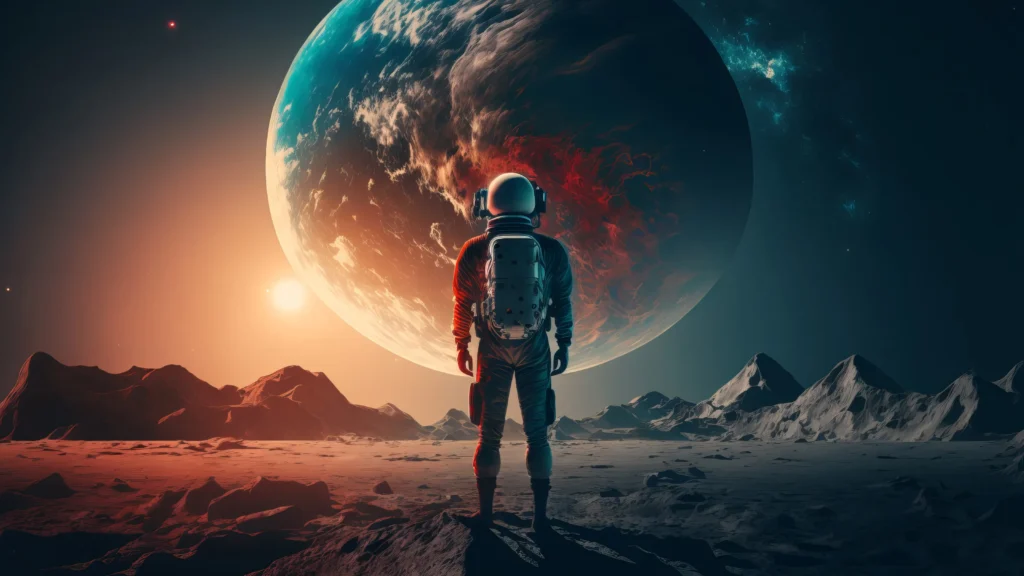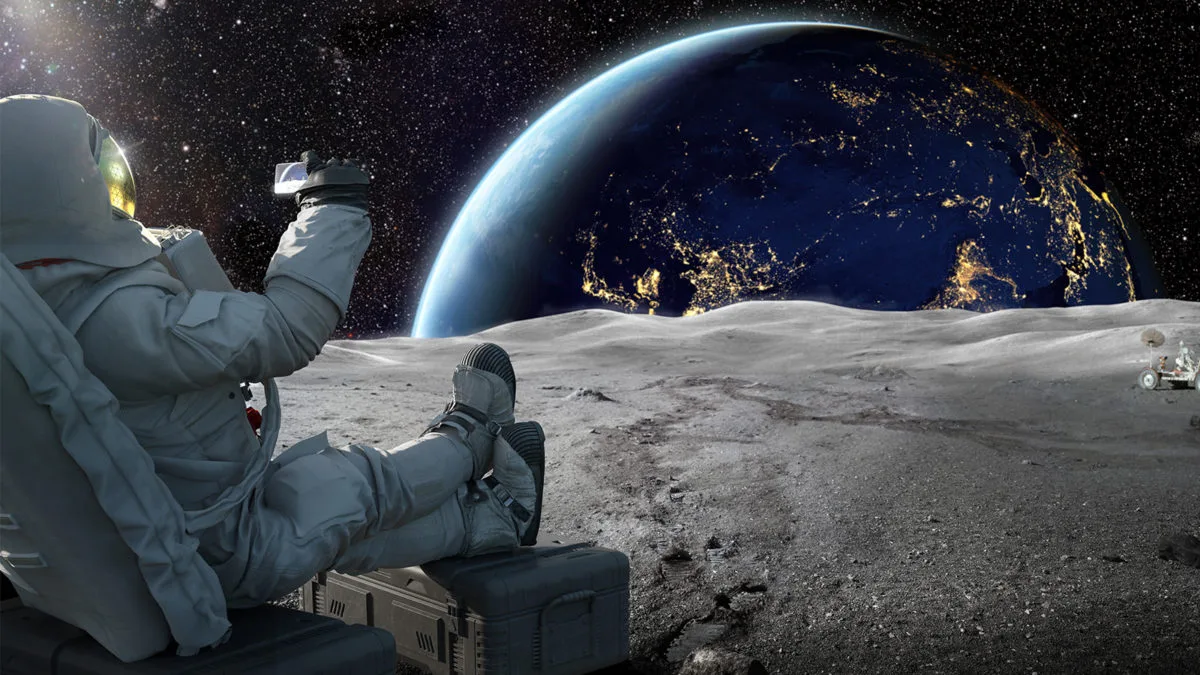
Space travel: The theory of time dilation is a fundamental concept in physics that stems from Albert Einstein’s theory of relativity. According to this theory, time is not absolute but rather relative to an observer’s frame of reference. Time dilation occurs when an object or person experiences time at a different rate compared to another object or person in a different gravitational field or moving at a different velocity.
Time dilation is a consequence of the bending of spacetime caused by gravity and the relative motion between objects. It suggests that the passage of time can vary depending on the strength of gravity or the speed at which an object is moving.
This theory has significant implications for our understanding of the universe and has been confirmed through numerous experiments and observations. The effects of time dilation are most noticeable in extreme conditions, such as near black holes or when indrabet space traveling at speeds close to the speed of light.

Contents
- 1 The effects of gravity on time
- 2 Time dilation in space
- 3 The Twin Paradox and time dilation
- 4 How astronauts experience time in space
- 5 Studies on the effects of space travel on aging
- 6 The impact of space travel on the human body
- 7 Mitigating the effects of space travel on aging
- 8 Other factors that affect aging in space
- 9 The relationship between space travel and aging
- 10 Author
The effects of gravity on time
In space travel gravity plays a crucial role in the theory of time dilation. According to Einstein’s theory of general relativity, massive objects like planets, stars, and black holes curve the fabric of spacetime around them. This curvature causes a distortion of the flow of time in their vicinity.
The closer an object is to a massive body, the stronger the gravitational force it experiences. As a result, time appears to pass more slowly in regions of strong gravity. This phenomenon has been confirmed through experiments, such as the famous Pound-Rebka experiment, where gamma rays were observed to have a lower frequency when emitted at the top of a tower compared to when they were detected at the bottom.
This gravitational time dilation has practical implications as well. For instance, atomic clocks placed at different altitudes on Earth tick at slightly different rates due to the variation in gravitational strength. These differences, though minuscule, need to be accounted for in systems that require precise timekeeping, such as GPS satellites.
Time dilation in space
When astronauts venture into space, they experience a unique environment where the effects of gravity are significantly different from those on Earth. As they move away from the planet’s gravitational field, they enter regions where the gravitational force is weaker. This change in gravity affects the passage of time for the astronauts.
In space, time dilation occurs due to the curvature of spacetime caused by the presence of massive objects like the Earth, the Moon, and the Sun. As astronauts travel farther from these objects, the gravitational force acting on them decreases, leading to a slower passage of time.
This means that while astronauts spend months or even years in space, the time they experience is slightly different from that of people on Earth. When they return to Earth, they would have aged less relative to their counterparts who remained on the planet. This phenomenon has been confirmed through experiments conducted on astronauts during space missions.
The Twin Paradox and time dilation
One of the most famous thought experiments related to time dilation is the Twin Paradox. It involves a pair of twins, one of whom remains on Earth while the other travels into space at high speeds and returns after a certain period.
According to the theory of relativity, the twin who travels into space will experience time at a slower rate compared to the twin who stays on Earth. When the traveling twin returns, they would have aged less than their sibling. This paradoxical situation arises from the difference in gravitational forces and relative motion experienced by the two twins.
The Twin Paradox has been studied extensively and serves as a powerful illustration of the effects of time dilation. While actual twins have not been used in experiments, atomic clocks on fast-moving airplanes and satellites have demonstrated the predicted time differences.
How astronauts experience time in space
For astronauts in space, the experience of time is not drastically different from what they are accustomed to on Earth. The effects of time dilation due to their relative motion and weaker gravitational forces are relatively small, especially during short-duration missions.
During their time in space, astronauts follow a carefully planned schedule that aligns with the mission objectives and their daily routines. Their perception of time is influenced by the activities they engage in, such as conducting experiments, exercising, or performing maintenance tasks. The presence of familiar routines helps them maintain a sense of normalcy despite being in an extraordinary environment.
Nevertheless, astronauts are aware that time is passing slightly differently for them compared to people on Earth. They undergo training to understand the effects of space travel on their bodies, including the potential impact on their perception of time. This awareness allows them to adapt and manage their activities effectively during their missions.

Studies on the effects of space travel on aging
Given the unique conditions of space travel, scientists have conducted various studies to understand the impact of extended periods in space on the aging process. These studies aim to shed light on whether astronauts experience any noticeable changes in their physiological or cognitive functions as a result of time dilation and other factors associated with space travel.
One notable study, known as the NASA Twins Study, involved astronaut Scott Kelly spending nearly a year aboard the International Space Station (ISS) while his identical twin brother, Mark Kelly, remained on Earth. The study aimed to compare the physiological and genetic changes between the two brothers to gain insights into the effects of long-duration space missions on the human body.
The results of the NASA Twins Study revealed several intriguing findings. While Scott experienced changes in gene expression, DNA methylation, and other physiological parameters, most of these changes returned to normal after his return to Earth. However, some subtle differences persisted, raising questions about the long-term effects of space travel on aging.
The impact of space travel on the human body
Space travel poses numerous challenges to the human body, including the effects of microgravity, radiation exposure, and psychological stress. These factors, in addition to time dilation, can have implications for the aging process and overall health of astronauts.
Microgravity, experienced during space travel, can lead to muscle atrophy, bone loss, and cardiovascular deconditioning. These effects can accelerate the aging process and increase the risk of age-related conditions such as osteoporosis and cardiovascular diseases.
Radiation exposure is another concern for astronauts. Beyond the protective shield of the Earth’s atmosphere, astronauts are exposed to higher levels of cosmic radiation, which can damage DNA and increase the risk of cancer. The long-term effects of radiation exposure on aging and overall health are still being studied.
Psychological factors also play a role in the impact of space travel on astronauts’ well-being. Extended periods of isolation, confinement, and the high-stress nature of space missions can contribute to psychological issues such as anxiety and depression. These factors can indirectly affect the aging process by influencing sleep patterns, hormone levels, and overall mental health.
Mitigating the effects of space travel on aging
To mitigate the potential negative effects of space travel on aging and overall health, scientists and space agencies are working on various strategies and technologies. These measures aim to protect astronauts during their missions and facilitate their successful return to Earth.
One such approach is the development of exercise protocols specifically designed to counteract the effects of microgravity on the musculoskeletal system. Astronauts onboard the ISS engage in regular exercise routines that include resistance training and cardiovascular exercises to maintain their muscle mass and bone density.
Radiation shielding is another crucial aspect of protecting astronauts from the harmful effects of cosmic radiation. Spacecraft and habitats are designed with shielding materials that minimize radiation exposure. Additionally, monitoring systems and protocols are in place to track astronauts’ radiation doses and ensure their safety.
Furthermore, psychological support and mental health resources are provided to astronauts before, during, and after their space missions. Regular communication with friends and family on Earth, access to counseling services, and the provision of recreational activities are among the measures in place to support astronauts’ mental well-being during their time in space.

Other factors that affect aging in space
While time dilation is a fascinating concept regarding the aging process in space, it is important to note that other factors also contribute to the overall experience of astronauts and their health.
The absence of gravity or the presence of microgravity can impact various physiological systems, including the cardiovascular, musculoskeletal, and immune systems. These changes, combined with the effects of time dilation, can affect an astronaut’s overall health and well-being.
In addition, the space environment poses challenges related to nutrition, hydration, and sleep. Astronauts must carefully manage their diets to ensure they receive adequate nutrients, maintain hydration, and adhere to sleep schedules despite the absence of natural day-night cycles.
The interaction between these factors and time dilation creates a complex web of influences on the aging process and overall health in space. Ongoing research and technological advancements are essential to further understanding and mitigating these effects as humans continue to explore and venture beyond Earth.
The relationship between space travel and aging
In conclusion, the concept of time dilation plays a significant role in the aging process of astronauts during space travel. As they venture farther from the Earth’s gravitational pull and experience different relative velocities, time appears to pass at a different rate for them.
While the effects of time dilation on aging are relatively small for short-duration missions, long-duration space travel may have more noticeable impacts on the human body and aging process. Factors such as microgravity, radiation exposure, and psychological stress contribute to the overall experience of astronauts and can influence their health and well-being.
Through studies like the NASA Twins Study and ongoing research, scientists continue to gain insights into the effects of space travel on aging and overall health. This knowledge is crucial for developing strategies and technologies to mitigate these effects, protect astronauts during their missions, and ensure their successful return to Earth.
As we look to the future and the possibility of humans traveling deeper into space, understanding the relationship between space travel and aging becomes increasingly important. By unraveling the mysteries of time dilation and its implications, we can pave the way for safer and more sustainable exploration of the cosmos, ultimately expanding our understanding of the universe and our place within it.
If you found this article intriguing and are keen on expanding your knowledge further, we invite you to explore our detailed piece on Nafe Singh Rathee, another fascinating topic that promises to enrich your understanding of remarkable individuals and their contributions.





